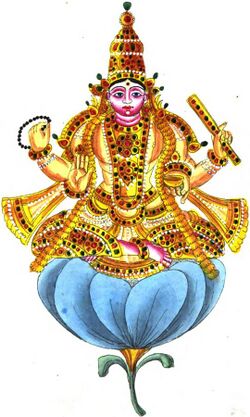Astronomy:Shukra
| Shukra | |
|---|---|
Venus | |
 Shukra as the deity of Venus graha | |
| Affiliation | Ancient: Guru of Asuras, Daityas;[1] Medieval: planet Venus, Graha |
Shukra (Sanskrit: शुक्र, IAST: Śukra) is a Sanskrit word that means "lucid, clear, bright". It also has other meanings, such as the name of an ancient sage who counseled Asuras in Vedic mythology.[1] In medieval mythology and Hindu astrology, the term refers to the planet Venus, one of the Navagrahas.[2]
Ideology
In one ideology, Shukra is the name of a son of Bhrigu, of the third Manu, one of the saptarishis. He was the guru of Daityas / Asuras, and is also referred to as Shukracharya or Asuracharya in various Hindu texts. He named the Velleeswarar Temple, Mangadu after the blessings of the Trimurti, to mark the end of a long period of blindness.[3] In another account found in the Mahabharata, Shukra divided himself into two, one half becoming the knowledge source for the Devas (gods) and the other half being the knowledge source of the Asuras (demons).[2] Shukra in the Puranic ideology is famed as one with the knowledge that raises the dead back to life, something that helps the violent evil return back to life even after the gods and the forces of good destroy them; this knowledge is sought by the gods and is ultimately gained by them.[2]
In the Mahabharata, Shukracharya is mentioned as one of the mentors of Bhishma, having taught him political science in his youth.[4]
Shukra's mother was Kavyamata, whilst Shukra's wife was the goddess Jayanti, and their union produced Queen Devayani.
Planet
Shukra as a planet appears in various Hindu astronomical texts in Sanskrit, such as the 5th century Aryabhatiya by Aryabhatta, the 6th century Romaka by Latadeva and Panca Siddhantika by Varahamihira, the 7th century Khandakhadyaka by Brahmagupta and the 8th century Sisyadhivrddida by Lalla.[5][6] These texts present Shukra as one of the planets and estimate the characteristics of the respective planetary motion.[5] Other texts such as Surya Siddhanta dated to have been complete sometime between the 5th century and 10th century present their chapters on various planets with deity mythologies.[5]
The manuscripts of these texts exist in slightly different versions, present Shukra's motion in the skies, but vary in their data, suggesting that the text were open and revised over their lives.[7][8][9]
The 1st millennium CE Hindu scholars had estimated the time it took for sidereal revolutions of each planet including Shukra, from their astronomical studies, with slightly different results:[10]
| Source | Estimated time per sidereal revolution[10] |
| Surya Siddhanta | 224 days, 16 hours, 45 minutes, 56.2 seconds |
| Siddhanta Shiromani | 224 days, 16 hours, 45 minutes, 1.9 seconds |
| Ptolemy | 224 days, 16 hours, 51 minutes, 56.8 seconds |
| 20th century calculations | 224 days, 16 hours, 49 minutes, 8.0 seconds |
Calendar and zodiac
The weekday Shukravara in Hindu calendar, or Friday, has roots in Shukra (Venus). Shukravara is found in most Indian languages, and Shukra Graha is driven by the planet Venus in Hindu astrology. The word "Friday" in the Greco-Roman and other Indo-European calendars is also based on the planet Venus. The zodiac and naming system of Hindu astrology likely developed in the centuries after the arrival of Greek astrology with Alexander the Great,[11][12][13] their zodiac signs being nearly identical.[14]
In Buddhist and Hindu astrology, Shukra (Venus) is a part of the medieval astrological explanations offered for various ailments.[15]
See also
- Varuna
- Asura
- Ahura Mazda
- Venus (astrology)
- Venus (mythology)
References
- ↑ 1.0 1.1 Charles Russell Coulter; Patricia Turner (2013). Encyclopedia of Ancient Deities. Routledge. p. 108. ISBN 978-1-135-96390-3. https://books.google.com/books?id=sEIngqiKOugC&pg=PA108.
- ↑ 2.0 2.1 2.2 Roshen Dalal (2010). Hinduism: An Alphabetical Guide. Penguin Books India. pp. 387–388. ISBN 978-0-14-341421-6. https://books.google.com/books?id=DH0vmD8ghdMC&pg=PA387.
- ↑ Gopal, Madan (1990). K.S. Gautam. ed. India through the ages. Publication Division, Ministry of Information and Broadcasting, Government of India. p. 72.
- ↑ Subramaniam, Kamala (2007). "Adi Parva". The Mahabharata. Bharatiya Vidya Bhavan India. ISBN 81-7276-405-7.
- ↑ 5.0 5.1 5.2 Ebenezer Burgess (1989). P Ganguly, P Sengupta. ed. Sûrya-Siddhânta: A Text-book of Hindu Astronomy. Motilal Banarsidass (Reprint), Original: Yale University Press, American Oriental Society. pp. vii–xi. ISBN 978-81-208-0612-2. https://books.google.com/books?id=W0Uo_-_iizwC.
- ↑ Bina Chatterjee (1970) (in Sanskrit). The Khandakhadyaka (an astronomical treatise) of Brahmagupta: with the commentary of Bhattotpala. Motilal Banarsidass. pp. 72–74, 40, 69. OCLC 463213346. https://books.google.com/books?id=WKOtRmgr1nkC.
- ↑ Lionel D. Barnett (1994). Antiquities of India: An Account of the History and Culture of Ancient Hindustan. Asian Educational Services. pp. 190–192. ISBN 978-81-206-0530-5. https://books.google.com/books?id=x40mwFwgK44C&pg=PA190.
- ↑ Ebenezer Burgess (1989). P Ganguly, P Sengupta. ed. Sûrya-Siddhânta: A Text-book of Hindu Astronomy. Motilal Banarsidass (Reprint), Original: Yale University Press, American Oriental Society. pp. ix-xi, xxix. ISBN 978-81-208-0612-2. https://books.google.com/books?id=W0Uo_-_iizwC.
- ↑ J Fleet (1911). Arbhatiya. Cambridge University Press for the Royal Asiatic Society. 794–799. https://books.google.com/books?id=1LssAAAAIAAJ.
- ↑ 10.0 10.1 Ebenezer Burgess (1989). P Ganguly, P Sengupta. ed. Sûrya-Siddhânta: A Text-book of Hindu Astronomy. Motilal Banarsidass (Reprint), Original: Yale University Press, American Oriental Society. pp. 26–27. ISBN 978-81-208-0612-2. https://books.google.com/books?id=W0Uo_-_iizwC.
- ↑ Yukio Ohashi 1999, pp. 719–721.
- ↑ Pingree 1973, pp. 2–3.
- ↑ Nicholas Campion (2012). Astrology and Cosmology in the World’s Religions. New York University Press. pp. 110–111. ISBN 978-0-8147-0842-2. https://books.google.com/books?id=MxSr1NT3BLoC.
- ↑ James Lochtefeld (2002), "Jyotisha" in The Illustrated Encyclopedia of Hinduism, Vol. 1: A–M, Rosen Publishing, ISBN:0-8239-2287-1, pages 326–327
- ↑ Walter Yeeling Evans-Wentz (2000). Tibetan Yoga and Secret Doctrines, Or, Seven Books of Wisdom of the Great Path, According to the Late Lāma Kazi Dawa-Samdup's English Rendering. Oxford University Press. p. 287. ISBN 978-0-19-513314-1. https://books.google.com/books?id=GjDEf0Hit2sC&pg=PA287.
Further reading
- Pingree, David (1973). "The Mesopotamian Origin of Early Indian Mathematical Astronomy". Journal for the History of Astronomy (SAGE) 4 (1). doi:10.1177/002182867300400102.
- Pingree, David (1981). Jyotihśāstra : Astral and Mathematical Literature. Otto Harrassowitz. ISBN 978-3447021654.
- Yukio Ohashi (1999). Johannes Andersen. ed. Highlights of Astronomy, Volume 11B. Springer Science. ISBN 978-0-7923-5556-4. https://books.google.com/books?id=gQYscrT0fgQC.


